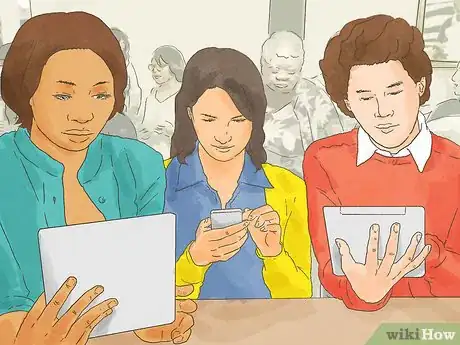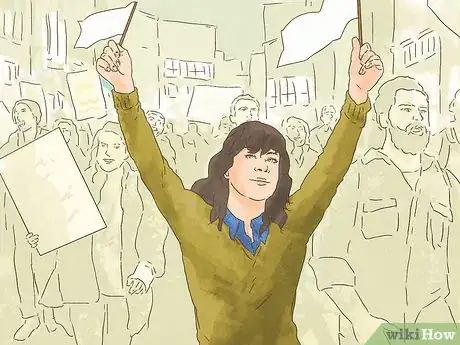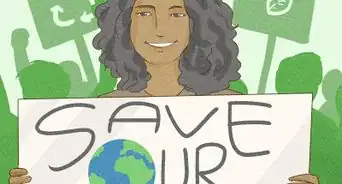This article was co-authored by wikiHow Staff. Our trained team of editors and researchers validate articles for accuracy and comprehensiveness. wikiHow's Content Management Team carefully monitors the work from our editorial staff to ensure that each article is backed by trusted research and meets our high quality standards.
There are 13 references cited in this article, which can be found at the bottom of the page.
wikiHow marks an article as reader-approved once it receives enough positive feedback. This article received 22 testimonials and 89% of readers who voted found it helpful, earning it our reader-approved status.
This article has been viewed 637,739 times.
Learn more...
To create a revolution, you need to unite people around a shared purpose. It’s possible to start a revolution, although it can take a lot of patience, organization, and passion. It will be more likely to succeed if you don’t wing it. A revolution (from the Latin revolutio, "a turnaround") is a significant change that usually occurs in a short period of time.
Steps
Picking a Theme
-
1Find a central theme around which to organize your revolution.
- You need to find such a central truth, whatever the revolution you are seeking. Find a way, in a simple sentence, to articulate your cause as a theory. Find a common purpose, and define it. Create a clear and eloquent message. What does your revolution stand for? What does it want to accomplish and why? Create a simple and powerful message that you can push out consistently.[1] [2]
- You will want a cause that connects to people’s deepest passions and their sense of right and wrong. Anchor this in what really matters and how it will create a better world.[3]
-
2Identify a need for reform. You can only build your case for change if you articulate why the present is broken. In addition to theory, you can do this by seizing on a specific need or concern that is backed up with data.
- Essentially, you are trying to articulate the reasons that change is necessary. Perhaps you want to change a single institution, like a school. Target a need or concern that is high profile and compelling. To use the educational example, this might be a high drop-out rate.
- Perhaps you want to change a government. If you can explain specifically how that government is letting people down – or endangering the environment or something specific like that – people will rally more to your cause.
Advertisement -
3Create concrete goals. It’s helpful for the revolution to know what it’s seeking to change. Legislation? A system of government itself? A simpler shaping of minds about a certain concept, like environmentalism?
- Breaking down your goals into smaller changes can help the revolution make actual change faster. For example, you might wish you could eliminate poverty throughout the world, but helping some local families in poverty might be a better place to start. You will see effects immediately.[4]
- You will need an action plan. This should be a written and/or visual model that can include responsibilities, activities, and timelines. Don’t just wing it. Sit down and plan. Measure progress, and use data constantly.
-
4Come up with a plan to secure resources. Perhaps you will need operational support. You will need people who are willing to donate money or time to the cause.
- Having a funding backer could be useful. Access to raw materials can also help. You will need to fund basic costs that you might not think of on the front end, such as postage, printing, permit costs, and a website. Seek donations.
- You need partners. People with resources (people, intellectual, financial or otherwise) who can join in and assist the organization. Don't try to do it yourself.
Finding Followers
-
1Choose a leader and symbol. Put a charismatic face on the revolution. Revolutions can take off when there is a charismatic face of the revolution to rally the masses. This can be someone already known or just a person who is particularly eloquent or who has standing on the issue. You need someone or something to represent your rebellion like a symbol. For example: Katniss is the Mockingjay.
- The leader can be the person with the original idea, or just a person who is courageous enough to take the heat.[5] Choose a spokesperson who is articulate and good on camera. Build rapport with TV and newspaper reporters to get your message out.
- There are some who advocate making all decisions by group and staying anonymous with no clear leadership, so leaders can’t be targeted or jailed by the opposition. Remember, though, that having a charismatic leader can be another strategy, and if that leader is targeted and jailed it can, in some circumstances, rally the masses to the cause (as in the case of Martin Luther King Jr.)
-
2Recruit activists. You need the people who will organize and lead the movement. These people must be committed and willing to work in the trenches and to devote their hearts and time to the cause. Motivate people to join because they believe in the cause. Give presentations at coffee houses or music stores or other places where you think receptive audiences congregate.
- The organizational team will require people with different skills and techniques. They will know how to interact with the media and how to get the masses to turn out for a protest. The average people might relate more to people like them than a charismatic leader. If they see other people they know or relate to joining in, they will feel more comfortable doing so themselves.[6]
- You cannot create a revolution with a single person. You need to remember the ground game. Creating a revolution is a painstaking process that requires grassroots organization. Build support and consensus: Nothing is going to happen if the only rebels are you and your buddies.This is an important step and the setup for either a successful revolution or a small civilian rebellion flop.
-
3Build partnerships with other people and groups. Seek supporters for your change. You will need people both inside and outside the institution or societal structure in question to have a better chance at achieving change. Don't succumb to the temptation of competition.
- Identify these people, and then seek their support. Pick people who are influencers and can themselves reach more people. Pick a mixture of people with different strengths. Build alliances, and link with other partners and people who are already working on the same cause or one related to it.[7]
- To create change, you will need at least 15% of the population to create a shift. Bring new people on board your team. Don’t turn only to the people you know. Find people whose skills are needed.Try to reach out to groups that are already organized and have membership lists and ground operations (unions are an example).
-
4Recruit intellectuals. It’s easier to start a revolution if its causes are supported by intellectuals. This can mean professors, researchers, authors, artists, speakers, and opinion writers.
- Intellectuals can help build the rationale for the revolution by articulating compelling theory. They can provide facts that will build the case. Many revolutions ignite with a deeper seminal work, such as Martin Luther King Jr.’s letter to Birmingham. King wrote this letter while in jail in response to a public statement issued by eight white southern religious leaders. It became a central document of the civil rights movement that defused the opposition and rallied support.
- The intellectuals can also help create a coherent and clear vision that will excite the masses about what the future can hold. Intellectuals can articulate what the new world or system will look like.
-
5Turn to scientists. Polemics matters, but grounding the movement in science and data can be particularly effective.
- Consider the global warming debate and how important science is to environmental movements as they seek to make their case.
- Ground the movement’s cause in scholarly research that is respected in its field, including from those who are not directly involved in the movement. It will be much harder for the opposition to refute the movement’s arguments.
Spreading the Message
-
1Remember the power of art and music. The rationale for a revolution can come from all artistic realms and areas of pop culture. You don’t only have to focus on the written word.
- Spoken word, poetry, music, and art – including public art – can advance your message and cause more effectively sometimes.
- Some art can be lasting. Consider a mural painted in a community. Music has the ability to influence minds all over the world.Try to humanize the movement. Make people care by telling the stories of real people whom the masses will identify with and care about.
-
2Embrace all of the potentials of the new media. You can also start a revolution through the quality of your own ideas. The Internet has given anyone the ability to publish and reach the masses.
- Create a blog. Install WordPress or another blogging service. Write a blog, and push it out to the masses. In it, create the intellectual foundation for why change is needed, and explain how change will look and what it would mean for your audience.
- Consider other formats as well. You might want to create a documentary. This can educate and motivate an audience. Don’t forget the power of shorter video. A You Tube series could help. Don’t have a one-prong media strategy. Use old and new media. Use the written word and multimedia like video. Use social media and blogs, but plant your message in traditional newspapers and magazines. Push your message out through multiple formats and mechanisms.
-
3Use social media to organize. Remember to harness the power of social media. Social media is a great way to get your messages in front of a lot of people.
- You can use social media to build attendance and events and to reach a targeted audience.[8]
- Remember not to only have a social media strategy. Revolutions are more successful when they organize both off and on the computer screen. Build support by handing out flyers and pamphlets, by word of mouth and advertisements and through today’s technology.
-
4Frame the debate. You can do this by choosing your words carefully. Choose your model of morality. In America, this is sometimes divided into “nurturant parent” or “strict father.”
- Consider how words like “freedom” create emotional response.[9] Anchor your words to people’s needs and your overall mission.
- Persuade through a mixture of pathos (emotional appeal), logos (appeal to reason), and ethos (ethical appeal). Build your case with logical reasoning and fact while adding in an emotional element.[10]
- Demonstrate the popularity of the movement to the people in power, legislature, and military. The greater the popularity among society, the more the likelihood of violent repression is reduced.
-
5Expect that people will react different ways to change. Researchers have found five stages in the process of change.
- The first phase is called “uninformed optimism,” and it’s the honeymoon phase of the project. There will be energy and enthusiasm at this point. However, problems will then crop up and “informed pessimism” results. Some change efforts may be abandoned.
- In order to continue with the movement, you will need hopeful realism, the third stage. This sets in when efforts succeed even though there were some problems. Informed optimism is when confidence comes back because things are still progressing. Finally, rewarding completion develops when you can show concrete results, and communicate them.
Choosing a Strategy
-
1Take Action. This is the most important step because the revolution dies without it. You must take action whether it is a nonviolent protest or a sit-in or a boycott.
- Your leader must motivate the support and dutifully work day and night to improve your revolution. But at some point, you need to do something, not just write about it or talk about it.
- The power in place will defend itself, for that is the nature of power. Illegitimate "governments" are not happy about a rebellion from their people and will do anything to crush resistance. Remember, your goal is the heart of your operation, your consensus is the mind of the revolution, and the actions you and your support take are the hands of your revolution.
-
2Work from within. Gain decision-making positions in key institutions. Some of those who have studied revolutions, like Saul Alinsky, have argued that revolutions are slow and require patience.
- Penetrate institutions that have power in society. Some of those can be churches, unions, and political parties. Gain influence within the decision-making ranks.
- Once in power, use the new platform to create change within the system. [11] Adapt and be flexible. Revolutionary movements must be adaptable to shifting political circumstances. Resilience can be important.[12]
-
3Find a target. You will need a foil to define your movement. Choose a target and then personalize it. Then polarize it. Do not choose violence. In one research study, it was found that non-violent resistance campaigns are twice as likely to succeed.
- Freeze the target by centering on the target, whether it’s an institution or a specific leader. Match your strong points against your enemy’s weak points. That’s according to Sun Tzu’s The Art of War. Perhaps the opponent has a stronger military, but you are cooler.[13]
- Don’t ever cause harm to anyone else. However, you can create an eloquent case for change by focusing on the words and actions of a single target institution, group, or person.
-
4Study past revolutions. You can create a revolution that is modeled on some of the principles that worked before. History is replete with revolutions that succeeded. The American Revolution. The French Revolution. The Civil Rights Movement.
- Revolutions often start by disorganizing the old or established organizations in society. Disorganize them by challenging their foundations and principles. Revolutions have happened throughout human history and vary widely in terms of methods, duration, motivating ideology, and the number of participating revolutionaries. Their results include major changes in culture, economy, and socio-political institutions.
- Once the old is disorganized, the new is able to better organize. Determine your tactics. Remember that power is what the enemy thinks you have. Keep the pressure on. Use ridicule. Hold the enemy to its own stated rules. Switch tactics because tactics can lose effectiveness if they drag on.
-
5Try civil disobedience. Sometimes people decide that political channels are not working so they take to the streets in a show of people power.
- For example, people have protested chemical factories in China and mining issues in Washington D.C. They have taken to the streets to protest what they see as police abuse.[14]
- You can try to work within the system but when that’s not working, you can work outside of it, but in a visible way – a hunger strike, a mass protest.
-
6Plan the protest. Research the rules of public spaces. Pick the time wisely (probably on a Friday so people are available to go.)
- Pick a spot that is in an area of public interest, pick a local political issue to activate people, and find a public space that can hold a lot of foot traffic. Research permit requirements and local laws and stay within them.
- Make sure decisions are made by groups, and make booths or art in order to generate messages from the scene. Consider offering free services to show what society is taking away (like library books). Follow the law.
Community Q&A
-
QuestionHow would we know when a revolution is needed?
 Community AnswerA revolution is always needed when something is not right and the ruling institutions will do nothing to make it right. When this happens, it means that the time has come for the people to come together and fight for their own interests, sometimes by fighting to press the establishment to reform itself, other times to take the matter (and the power) into their own hands.
Community AnswerA revolution is always needed when something is not right and the ruling institutions will do nothing to make it right. When this happens, it means that the time has come for the people to come together and fight for their own interests, sometimes by fighting to press the establishment to reform itself, other times to take the matter (and the power) into their own hands. -
QuestionWhat if your revolution is crushed?
 Community AnswerSupposing that you did start a revolution, people got involved, took action, fought the powers that be, and only then were defeated, you can go back home knowing that, even though you have been beaten, the seed has been planted and can grow again stronger in the future. You can find many examples of this throughout history. The Russian proletariat was massacred in January 1905 in what is known as the Bloody Sunday, only to strike once more in 1917, successfully dethroning the Tsar, and, months later, the Mensheviks, in the events that led to the forging of the Soviet Union. Fight to educate the masses in your cause, so that they can rise again when the time is right.
Community AnswerSupposing that you did start a revolution, people got involved, took action, fought the powers that be, and only then were defeated, you can go back home knowing that, even though you have been beaten, the seed has been planted and can grow again stronger in the future. You can find many examples of this throughout history. The Russian proletariat was massacred in January 1905 in what is known as the Bloody Sunday, only to strike once more in 1917, successfully dethroning the Tsar, and, months later, the Mensheviks, in the events that led to the forging of the Soviet Union. Fight to educate the masses in your cause, so that they can rise again when the time is right. -
QuestionHow can I help the people to understand my cause when they are brainwashed by the government controlled media?
 Community AnswerWrite a speech, do research and find out what people will believe and understand. Back up your points with research from reliable sources you can cite, and make sure whoever's reading/listening to your speech will understand what you're saying.
Community AnswerWrite a speech, do research and find out what people will believe and understand. Back up your points with research from reliable sources you can cite, and make sure whoever's reading/listening to your speech will understand what you're saying.
Warnings
- As in many revolutions in the past, you could be killed in war, attacked, tortured, become a prisoner, etc. by people in power who are protecting their interests. But that does not mean the movement and cause cannot overcome if enough resolve is there. They are only methods those in power partake in to intimidate and try to put the fire of revolution out before it consumes them.⧼thumbs_response⧽
- A revolution is not about you, it's about everyone collectively. Do not try to take fame.⧼thumbs_response⧽
- Never let the purpose of the revolution be led by the will of a single person or group; adherents must be ruled only by their legitimate cause.⧼thumbs_response⧽
- Have some idea about how you want society to look like after the revolution. If structures to take over are not in place, innocent people might suffer.⧼thumbs_response⧽
References
- ↑ http://www.huffingtonpost.com/anna-clark/how-to-start-a-revolution_b_4856734.html
- ↑ http://www.forbes.com/forbes/welcome/
- ↑ http://blogs.worldbank.org/voices/5-tips-on-starting-a-social-movement
- ↑ http://www.themiddlefingerproject.org/how-to-start-a-revolution-or-3-ways-to-change-the-world-2/
- ↑ http://www.huffingtonpost.com/kari-henley/starting-a-movement_b_828381.html
- ↑ http://www.huffingtonpost.com/kari-henley/starting-a-movement_b_828381.html
- ↑ http://www.thenation.com/article/ten-things-start-movement/
- ↑ http://www.themiddlefingerproject.org/how-to-start-a-revolution-or-3-ways-to-change-the-world-2/
- ↑ http://www.theguardian.com/sustainable-business/george-lakoff-green-marketing
- ↑ http://plato.stanford.edu/entries/aristotle-rhetoric/
- ↑ http://www.discoverthenetworks.org/individualProfile.asp?indid=2314
- ↑ http://www.crossroad.to/Quotes/communism/alinsky.htm
- ↑ http://www.theguardian.com/world/2015/mar/08/five-ways-start-revolution-srdja-popovic-humour-non-violence
- ↑ http://www.onthecommons.org/how-start-revolution-our-time
About This Article
To start a revolution, first you need to identify something that you want to change, like the rules at your school or your government's policies. Then, come up with specific, concrete goals, and start recruiting people, whether they're friends, activists, intellectuals, scientists, or another group that could help your revolution. Once you've got people involved, work on spreading your message through things like social media, art, music, and the Internet. To learn how to choose a strategy for your revolution, scroll down!
















-Step-7-Version-2.webp)
































































